Granular Flake ice vs Scale ice
|
|
The purpose of these trials was to ascertain the storage characteristics of two popular kinds of ice known generally under the umbrella term 'flake ice'. Ziegra offer both types of ice and so we often speak to customers about the relative merits of each.
Scale ice is made at -7ºC, and it is well understood that it will freeze together if allowed to melt during storage, whereas Granular flake is made at an ideal -0.5ºC so is not cold enough to re-freeze its own meltwater.
Despite these facts being well known, little work has been done to establish parameters for the storage of these types of ice. While it is OK to advise that scale ice should not be stored for too long in temperatures that are too warm, how long is too long, and what is too warm?
Again while saying that in general, granular flake will not freeze together during extended storage is OK, what are the limits?
This is what we set out to answer in these trials.
We decided to use our 1,000 litre insulated ice boxes with lids, which each hold around 500kg of ice. These boxes have lids so can be completely sealed agains the elements, good insulation properties and drains. While scale ice is only available in one size, granular flake is available in small, medium and large. For these trials we decided to use the macro size due to its higher surface area and therefore theoretically lower melt rate to set a benchmark.
|
| |
|
|
| For those who would rather watch a video, please click here to go to youtube: https://youtu.be/zmbFEMDcyfU |
Winter conditions trial
|
| |
|
|
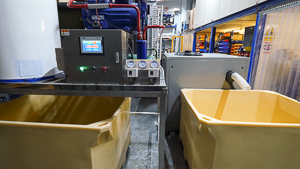 |
|
As we didn't know what to expect from the scale ice, we decided to carry out an initial short 48 hour trial during the winter months to give the ice the best chance. On 28th Novmber 2017, the two boxes were filled with scale and granular flake ice at the same time side by side. The scale ice was made by a 3 tonne machine while the granular flake was made by a 2 tonne machine. After filling the lids were fitted and the bins moved outside. |
| Boxes being filled side by side |
|
|
| |
| During the course of the November 2017 trial, the maximum recorded temperature was logged at 6ºC and the minimum as 1ºC. With the well drained, insulated boxes and lids, this is as close to ideal ice storage conditions that can be achieved oustside of a temperature controlled ice silo. |
| |
|
|
|
On 30th November 2017, after 48 hours of storage the lids were removed from the boxes and the melt losses were found to be negligible in both cases.
|
|
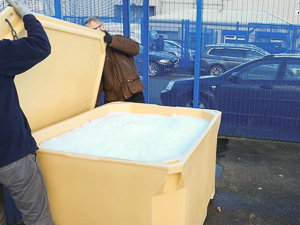 |
| |
|
Removing the lids |
| |
|
|
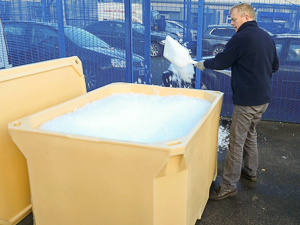 |
|
The granular ice was found to be loose and friable with no lumping. The box was emptied easily using a poly moulded ice shovel in 8 minutes.
100% of the ice usable with no breaking apart needed
|
| Granular ice remains loose and friable |
|
|
| |
|
|
|
The scale ice was found to have approximately the first 150cm of depth at the top frozen into large lumps. This 'crust' was diffiult to get through with the poly ice shovel, but the bin was emptied in around 11 minutes, with the only other frozen lumps found in the middle and at the bottom of the box.
70% of the ice useable, a further 20% useable after some breaking apart, with only around 10% deemed completely unusable.
|
|
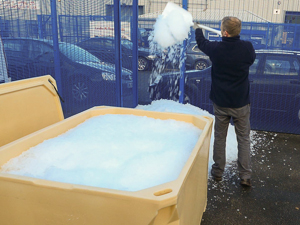 |
| |
|
Scale ice mostly OK after breaking through the crust |
| |
|
|
| Conclusion: 48 hour storage at cold temperatures between 2ºC and 5ºC are no problem for granular flake and not too bad for scale ice either. |
| |
|
|
Spring conditions trial
|
| |
|
|
|
For the spring conditions trial we decided to make things a little more interesting and opted for a 120 hour storage test. The boxes were filled as before on 4th April 2018, drains open and lids fitted. During the 120 hour storage period the highest recorded air temperature around the boxes was 14ºC, while the lowest overnight was 1ºC. The average temperature for the trial was 8.1ºC. These are fairly favourable temperatures for the storage of ice, perhaps a little warm for scale ice, however 120 hours represents quite a long storage period. After removing the lids on 9th April, the melt losses were again fairly negligible, which is a testament to just how good the IB500 boxes are. The level in each box had only dropped by around 50-60mm which considering the length of time the ice had been stored is very good. The question is, what condition was the ice in?
|
| |
|
|
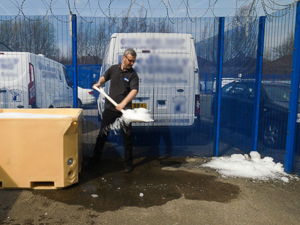 |
|
We tackled the scale ice first and as expected this proved to be a difficult job with a hard top crust and many frozen sections throughout the box. In the end it took around 16 minutes to empty the box due to the breaking of the ice required.
40% of ice found usable, 30% usable after some work breaking it apart, with the remainder unusable.
This is a bridge too far for scale ice and storage for these times and temperatures are not recommended.
|
| Shovelling lumps of scale ice |
|
|
| |
|
|
|
The granular flake was emptied next and unlike the first winter trial, the difference was night and day. There were only two small lumps found in the whole box and even these broke apart very easily after a tap with the shovel.
The rest of the ice was as loose and friable as when the box was filled.
The box was easily emptied in just under 8 minutes.
100% of the ice usable.
|
|
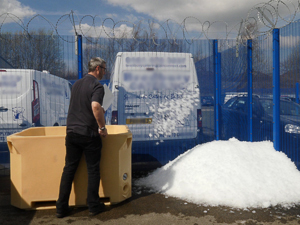 |
| |
|
Emptying the granular flake ice |
| |
|
|
|
Conclusions drawn from the Spring trial
While it was difficult to draw any clear conclusion from the winter trial, this trial left no doubt, 120 hours is far too long for ambient storage of scale ice, even at these fairly low temperatures. Granular flake ice on the other hand was almost perfect and apart from the small melt losses experienced no ill effects from this extended storage.
|
| |
|
|
Summer conditions trial
|
| |
|
|
| Even though scale ice struggled during our spring trials above, we decided to take advantage of the 2018 heatwave in July and carry out a torture test on both ice types just to see what happens. As in the earlier trials, two boxes were filled, one with each type, drains opened and lids fitted as per best practice for storing ice. The boxes were filled on 19th July 2018 and stored outside in the sun for 120 hours with just the IB500 boxes for protection. The maximum recorded temperature during the trial was 23 and the minimum 11 with the average being 18.6 over the 120 hours. We expect big melt losses at these temperatures for both types, but what we really wanted to know was the condition of the remaining ice when the boxes were finally opened. |
| |
|
|
| The box containing scale ice was opened first and as expected at this storage temperature and duration, melt loss was significant. |
|
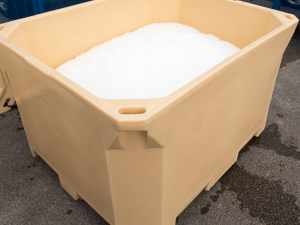 |
| |
|
Scale ice bin after 120 hours of summer sunshine |
| |
|
|
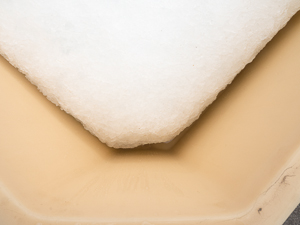 |
|
As is usual the ice had melted away from the side of the insulated container. Air is a good insulator, so after a certain gap has formed, usually after a few hours, melt from this direction tends to stop. |
| Air gap formed between ice and container wall |
|
|
| |
|
|
|
The level in the box had dropped by around 270mm from the starting point of 700mm depth, so when combined with the shrinking away from the sides shown above represents a melt loss a little more than 40%.
|
|
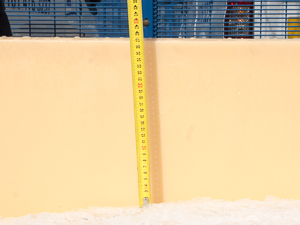 |
| |
|
Ice shrinkage after extended high temperature storage |
| |
|
|
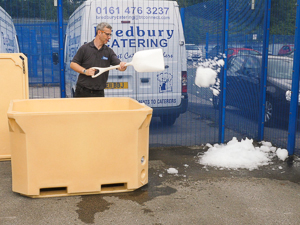 |
|
The scale ice left after the trial was very tough to remove with heavy breaking up of the ice required before it could be shovelled, this left a lot of large lumps with jagged edges.
It took nine minutes to empty the box
15% ice found usable with15% ice usable after some breaking apart and the remaining 70% unusable.
Predictably scale ice is not suitable for extended storage at these temperatures.
|
| Emptying the scale ice box |
|
|
| |
|
|
| Next it was the turn of the granular flake ice, as with the scale ice the melt loss was significant. |
|
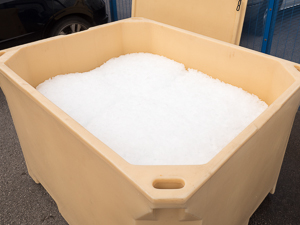 |
| |
|
Granular flake ice after 120 hours of summer sunshine |
| |
|
|
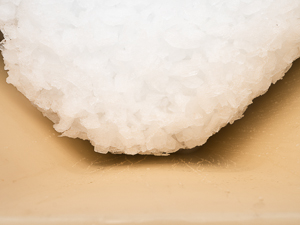 |
|
As usual the ice had melted away from the side of the insulated container. Air is a good insulator, so after a certain gap has formed, usually after a few hours, melt from this direction tends to stop. This happens with all ice types in storage. |
| Air gap formed between ice and container wall |
|
|
| |
|
|
|
The level in the box had dropped by around 230mm from the starting point of 700mm depth, so when combined with the shrinking away from the sides shown above, this represents a melt loss of around 35%
The reason the melt losses are less for macro ice is that they are fairly large, thick pieces that have been designed specifically for long term / ambient storage.
The real question though is what condition is it in?
|
|
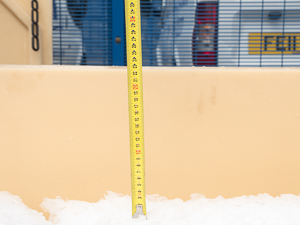 |
| |
|
Ice shrinkage after extended high temperature storage |
| |
|
|
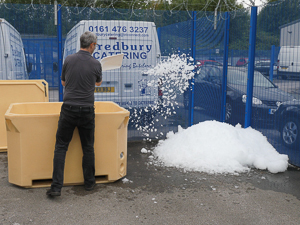 |
|
While we are well aware of how well granular flake ice stores, especially the macro flake size, even we were surprised at just how good it was.
The ice was in just as good condition as when it first went in the box, remaining loose and friable with no lumping or freezing together.
The bin was empited effortlessly in 6 minutes.
|
| Emptying the granular ice box |
|
|
| |
|
|
|
Conclusions from the summer trial
Obviously, after the performance during the spring trials we were not exactly shocked when the scale ice turned in such a poor performance during this torture test and it was only included to make the comparison complete.
The granular flake ice however if anything exceeded our expectations. The combination of good storage practice and an ideal ice type delivered a stunning result, despite the extreme storage temperature. All 470kg of remaining ice was completely usable with not a sharp edge in site.
If this ice were stored using the practice outlined during these trials, with insulated, well sealed, well drained storage combined with temperature management, we wonder just how long it could be kept.
|
| |
|
|
Overall conclusion
Scale ice: suitable for short storage periods of a day or two at lower ambient temperatures below 5ºC. At higher ambient temperatures it should be ideally used either straight away or certainly within a few hours to avoid problems. Not recommended for longer periods or higher ambient temperatures.
Granular Flake ice: Suitable for long term storage in ambient temperatures from 2ºC up to 20ºC. The other two sizes (midi and micro) would probably melt a little faster due to their smaller particle size and therefore higher surface area, but their storage characteristics should be the same.
For future trials it would be interesting to compare macro ice as the benchmark for long term storage with the smaller granular flake sizes to see just what the difference in melt rate is at a given time/temperature combination.
A long term trial past 120 hours would also be interesting at ambient temperatures between 2 and 10 to see just how far we can push our luck.
Also it would be good to see how scale ice stores longer term when stored in its ideal environment, the freezer.
Watch this space.
|
| |
|
|
| |
|
|